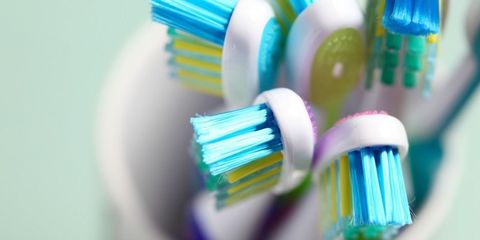
A new bathroom cleanliness study from the American Society for Microbiology has our skin crawling — and double-checking our toothbrush storage tactics.
Researchers found that when college students use communal bathrooms, their toothbrushes often share the group's collective fecal bacteria. This feels pretty obvious (force a swath of not-so-clean college kids together, and bacteria is bound to make the rounds), but we can't help but think that conditions could be similar in a highly trafficked family bathroom.
Your knee-jerk reaction to protect your toothbrush from germs might be to store it inside a medicine cabinet or travel container, away from other surfaces and, of course, your toilet. But this tactic is actually a really bad move.
"Using a toothbrush cover doesn't protect a toothbrush from bacterial growth, but actually creates an environment where bacteria are better suited to grow by keeping the bristles moist and not allowing the head of the toothbrush to dry out between uses," says Laura Aber, the study's graduate student researcher.
The American Dental Association recommends that you store toothbrushes so they can air-dry in upright position, and so they don't touch each other.
But the real key to minimizing the spread of germs starts with your toilet. Closing the lid before flushing is essential — lest you want poop particles to land on your toothbrush (and everywhere else within six feet of the bowl).
As for your college kid who can't control what her dorm-mates do in the bathroom? The study's researchers suggest following the ADA's guidelines as closely as possible: Rinsing the brush thoroughly after use, replacing it after three or four months, and storing it so it can air-dry (a cup in a discreet corner of her room is better than a travel case).
No comments:
Post a Comment